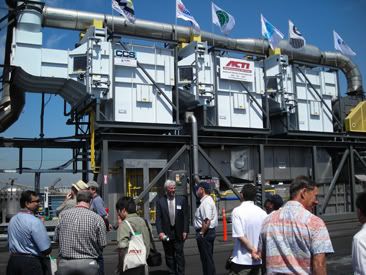
I know I use the term “long-awaited” pretty often, but I must use it again today. On Thursday, June 19th, I was able to witness the (yes) long-awaited demonstration of the “AMECS” – the Advanced Maritime Emissions Control System – at Pier G in the Port of Long Beach. I’ve certainly been waiting for this for a long time – I first heard about the “sock on a stack” technology nearly three years ago, and learned of the prospect of a Long Beach demonstration many months ago, if not close to a year.
The basic idea of AMECS is simple: a flexible bonnet is placed on the exhaust stack of a marine vessel, and the emissions are ducted to a series of emission control scrubbers that knock out the majority (well over 90%) of the pollution. The method has been successfully demonstrated on locomotives at Union Pacific’s rail yard in northern California, but this is the first time the public has been treated to a demonstration of its application to marine vessels.
The demonstration was witnessed by a crowd of perhaps a hundred fifty people, gathered in a tent at Berth G-214 in Metropolitan Stevedore’s bulk terminal. The Japanese vessel Ginga Merlin had been berthed for the demonstration, though presenters said that it took a series of phone calls to Japan, as late as 3 o’clock that very morning, to confirm that the ship would be available! State Senator Dean Florez was among those credited with having made the calls and convinced the company to participate.
The bonnet was on the stack when we arrived, and after introductory remarks, the demonstration consisted of lifting it off the stack for a few minutes, then replacing it. As it lifted off, we could clearly see the smoke that it had been capturing, now drifting off into the sunlit sky. You could scarcely ask for a more graphic demonstration of how effective the bonnet was. All I could think was, “Lower it back down!” Flexible ductwork led to rigid ductwork feeding the fumes into three “cloud chamber” scrubbers and a selective catalytic reduction unit that together reduce sulfur oxide emissions, nitrogen oxide emissions, and particulate matter emissions each by 98%, and volatile organic emissions by 96%. The system can be placed at dockside, or mounted on a barge for mobile applications around a harbor.
My euphoria at seeing this demonstration – and there seemed to be general euphoria, not just my own – was deflated a bit when I learned from an associate that the system makes use of a diesel generator to provide power for the scrubbing equipment, meaning that it creates some additional greenhouse gas emissions. However, I suspect this apparent flaw can be corrected.
What’s next for Advanced Cleanup Technologies Inc., the Rancho Dominguez-based AMECS developer? Their system must now get environmental agency certification before it can be commercialized. All three levels of government – federal (Environmental Protection Agency), state (Air Resources Board), and local (South Coast Air Quality Management District) – require their own process to provide the “seal of approval,” but the speed and coordination of these processes are not well-defined or guaranteed. In other words, collectively, we are not yet experts at verifying and certifying new emission control technologies. Despite this, I hope the agencies move quickly so that this very flexible technology can be deployed widely and soon.


